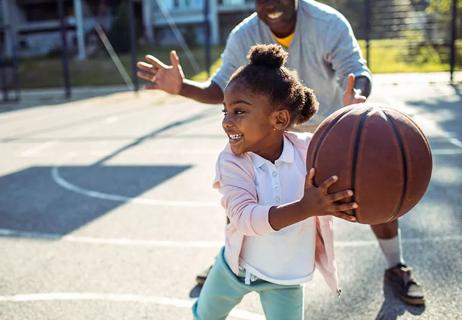Protective equipment like sports cups can help avoid injury

Helmets, padding, shin guards, gloves and … a cup?
Advertisement
Cleveland Clinic is a non-profit academic medical center. Advertising on our site helps support our mission. We do not endorse non-Cleveland Clinic products or services. Policy
You might be wondering exactly what you need to keep your athletic youth safe when they tackle their next big sports season. But athletic cups (also called sports cups and protective cups) are an important yet often overlooked piece of sports equipment that can help protect their groin from potential injury.
Certified nurse practitioner Kimberly Slocombe, CNP, explains just what an athletic cup can do for active youth.
Athletic cups are historically worn by people with testicles because they hang outside of the body and are left vulnerable to impact. But anyone who plays high-contact sports, regardless of their sex assigned at birth, can wear groin protection every time they play if they’re worried about injury.
“Cups lower the risk of injuries by protecting the groin from an impact with a ball, puck or another person,” says Slocombe.
Sports cups, or protective cups, soften blows to the groin while transferring the shock of the impact away from highly sensitive and vulnerable body parts like testicles. Pelvic protectors and groin guards (sometimes called female groin protectors) are also available to offer protection to the vagina and lower abdomen, as well to prevent bruising or tearing.
Advertisement
“A child needs to wear a cup as soon as they start playing contact sports,” advises Slocombe. “For some kids, that’s as early as age 5.”
In addition to offering much-needed protection, starting early helps kids learn to think of the devices as essential sports equipment.
“Wearing a cup should become routine just like putting on a helmet or shin guards,” she adds.
Your child should wear an athletic cup if they participate in high-impact sports, such as:
A direct hit to the groin can lead to serious injuries that can include:
It’s important to note that sports hernias aren’t actual hernias — they’re usually tears in the muscles of your lower abdomen or groin associated with nerve irritation or pain. Healthcare providers refer to these as “athletic pubalgia.” If left untreated, athletic pubalgia can lead to an eventual hernia, though the two are different conditions.
“Blunt trauma to the groin can cause severe testicular pain and other medical emergencies,” says Slocombe.
In the most severe cases, if a child loses a testicle as a result of a groin injury, it could increase their future risk of:
Shopping for athletic cups (especially if you’re shopping for someone else, like your child) can be challenging. There are different sizes, materials and ways to wear cups, which adds to the confusion. These tips can make the process a little easier for you and your kid.
Because kids grow and mature physically at different paces, Slocombe recommends choosing a cup size based on your child’s waist circumference, not their age — and most brands sell cups this way.
Athletic cup sizes may have the following ranges:
| Waist size | Sports range | Sports cup size |
|---|---|---|
| 19 to 22 inches | Peewee | Extra small |
| 22 to 28 inches | Youth | Small |
| 28 to 30 inches | Teen | Medium |
| 30 to 46 inches | Adult | Large |
| Waist size | ||
| 19 to 22 inches | ||
| Sports range | ||
| Peewee | ||
| Sports cup size | ||
| Extra small | ||
| 22 to 28 inches | ||
| Sports range | ||
| Youth | ||
| Sports cup size | ||
| Small | ||
| 28 to 30 inches | ||
| Sports range | ||
| Teen | ||
| Sports cup size | ||
| Medium | ||
| 30 to 46 inches | ||
| Sports range | ||
| Adult | ||
| Sports cup size | ||
| Large |
In the past, athletic cups were made from metals like perforated steel. They were strong but not very comfortable. Today’s athletic cups are made from materials like molded polymer plastic (with airholes for ventilation) or carbon fiber (a super-strong, breathable fabric). Some cups also have cushioned gel padding around the edges for added comfort.
“The cup material is often a matter of preference,” notes Slocombe.
Young athletes who play sports with a lot of player-on-player contact, like football and hockey for example, may want a sturdier plastic material than those who play soccer or other sports with less frequent player contact.
Advertisement
There are different options for keeping an athletic cup in place. Regardless of your child’s preference, make sure they wear the cup with the narrow end pointing down toward their feet and the wider part up toward their waistline. In every case, you’ll want to follow the instructions that come with the cup to make sure it’s worn correctly.
Options for keeping an athletic cup or groin protector in place include:
“Getting the proper size and fit can be tricky,” says Slocombe. “The general rule is that an athletic cup should fit snugly against the groin but shouldn’t press up against your testicles or skin.”
Advertisement
To check for fit, have your child run, jump, lunge and squat while wearing a cup. Your child may need a smaller cup size if the cup feels loose or shifts. If your child complains about pinching or chafing, they may need a larger cup size.
“I often hear athletes say they can’t run or move as well while wearing a cup,” says Slocombe. “That comment tells me they’re either wearing the wrong size or wearing the cup incorrectly. A properly fitting athletic cup shouldn’t affect movements.”
And because kids aren’t always the best judge of what qualifies as “a good fit,” you may want them to see their healthcare provider for a quick assessment before purchasing new equipment.
This question resonates particularly strongly with parents or caregivers after a big game. Read the directions on the packaging for information on how to clean a sports cup. Sometimes, you can toss it into the washing machine with the rest of your kid’s stinky athletic gear. Or you may need to handwash the cup or protector with hot water and laundry detergent or antibacterial soap. Any way you choose to handle them, they should always air-dry after being washed.
“It’s helpful to have multiple sports cups, so your child can switch them out in between activities and cleanings,” suggests Slocombe.
Advertisement
Learn more about our editorial process.
Advertisement

Kick up your metabolism by strategic eating

Each child and condition is unique, but most kids can play with proper precautions

An annual exam looking at heart health

An expert explains the potential benefits

Takeaways from sports psychology

For starters, they’re not just football injuries

What you can do to be the ideal sports parent

Athletic trainers help keep student athletes safe, healthy and happy.

Type 2 diabetes isn’t inevitable with these dietary changes

Applying a hot or cold compress can help with pain